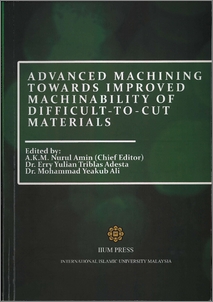Amin, A. K. M. Nurul and Abd Aziz, Amir Akhyar and Mahmud, Md. Asif
(2011)
A new method for chatter suppression and improvement of surface roughness in end milling of mild steel.
In:
Advanced Machining Towards Improved Machinability of Difficult-to-Cut Materials.
IIUM Press, Kuala Lumpur, Malaysia, pp. 83-90.
ISBN 9789674181758
![[img]](http://irep.iium.edu.my/style/images/fileicons/application_pdf.png)  Preview |
|
PDF (A new method for chatter suppression and improvement of surface roughness in end milling of mild steel)
- Published Version
Download (559kB)
| Preview
|
Abstract
Chatter is an abnormal tool behaviour which it is one of the most critical problems in machining
process and must be avoided to improve the dimensional accuracy and surface quality of the
product [1]. The most critical limitation in machining productivity and part quality is the
occurrence of the instability phenomenon called regenerative chatter [2]. According to
Ravikumar and Bhaskar [2] chatter is a self-excitation phenomenon occurring in machine
tools, in which the cutting process tends to decrease the machine structural damping
ending with an unstable behaviour. It results in heavy vibrations of the tool, causing an
inferior work piece. According to Patwari and Amin [3] chatter is a very important
phenomenon that needs to be taken into consideration whenever machining process is being
performed. It is very important to avoid chatter in machining as it will effect others parameters
which then will increase the cost of production. In a micromilling process, where the spindle
rotates an end mill to remove a portion of the workpiece, the unstable phenomenon, regenerative
chatter also occurs due to changes in the chip thickness similar with the macro machining [4-5].
Altintas and Chan [6] stated that one of the major limitations on productivity in metal
cutting is chatter vibration, which causes poor surface finish and tool damage. Kim et al.
[7] explained that most of the drawbacks that come from chatter are excessive tool wear,
noise, tool breakage, and deterioration of the surface quality. Moreover chatter also results
in reduced material removal rate (MRR), increased costs in terms of time, materials and
energy, as well as the environmental impact of dumping non-valid final parts and having
to repeat the manufacturing process as quoted from Quintana [8].
Actions (login required)
 |
View Item |


 Download Statistics
Download Statistics Download Statistics
Download Statistics